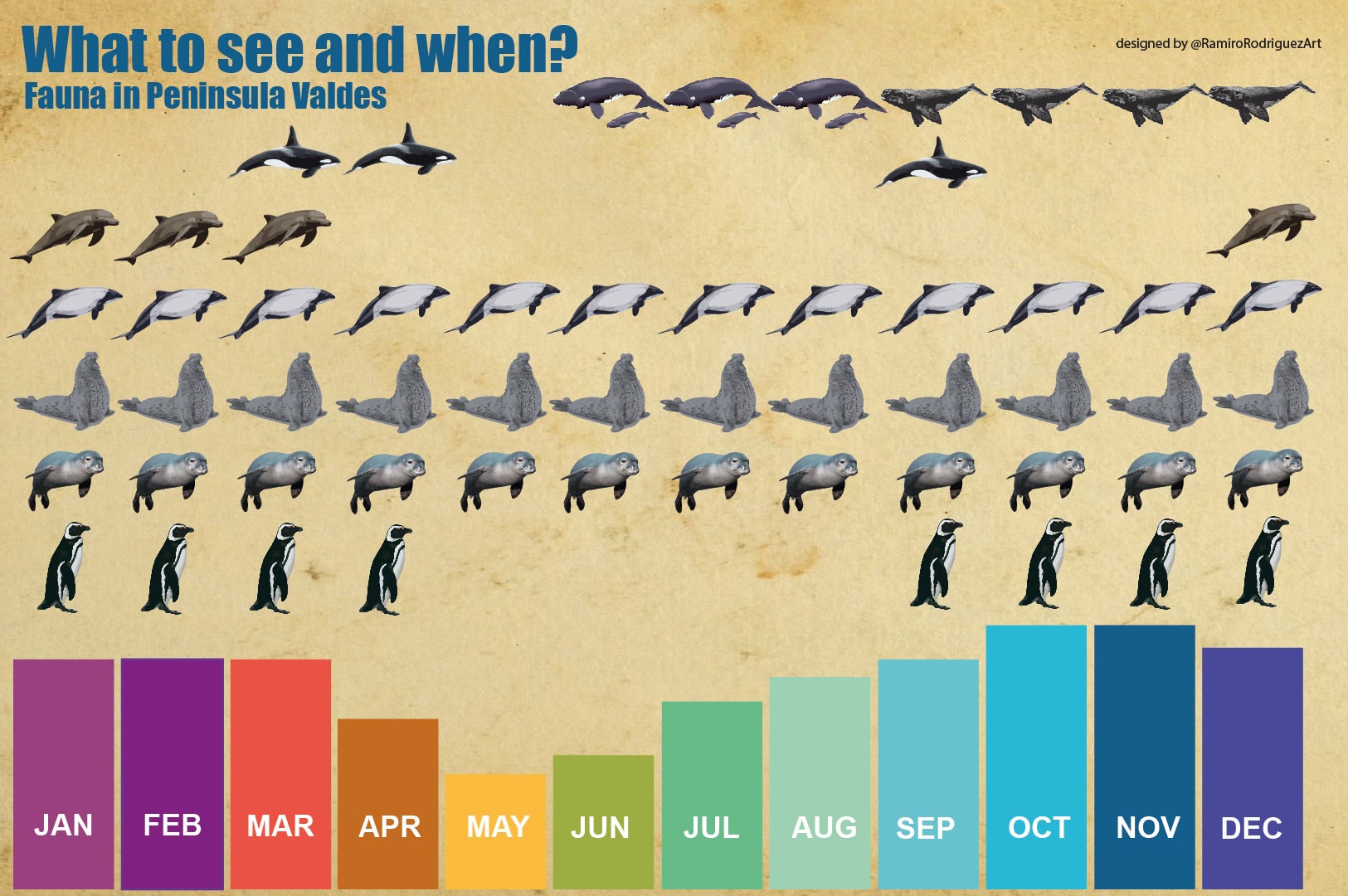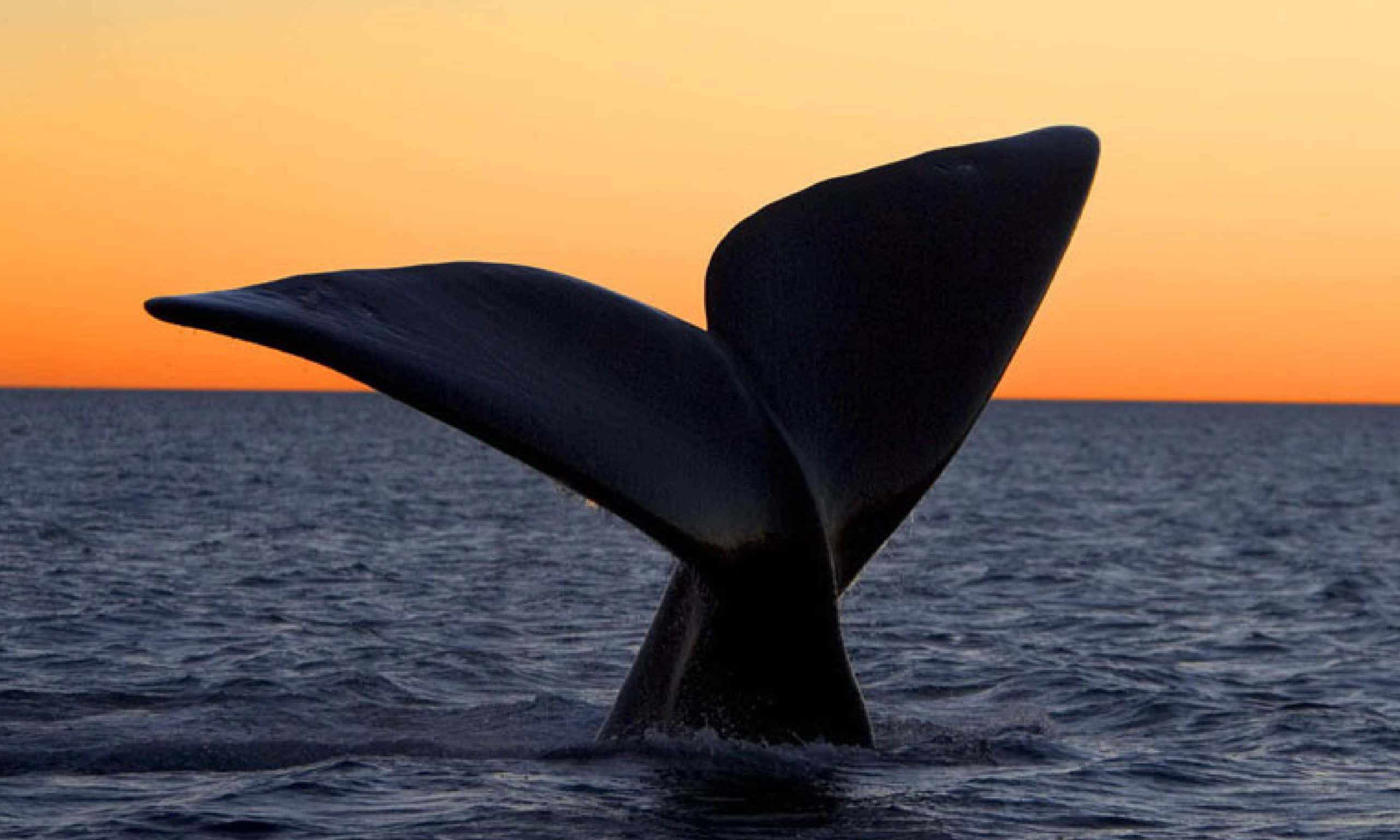Puerto Madryn: What to see in Puerto Madryn and Peninsula Valdes area?
Puerto Madryn is the gate to visit many incredible natural attractions in the area of Peninsula Valdes. Of course whales, penguins, sea lions, elephant seals and other sealife and land fauna, but also some interesting attractions like the MEF Museum of Dinosaurs of Patagonia, or the small village of Gaiman to discover the welsh settlement and taste an exquisite welsh tea. Of course, the highlight of the area is the sealife. Take a look to some interesting attractions of what to see and when to see different animals like whales, penguins and more:
Whales! When to see these incredible animals?
Whales are may be, the highlight attraction in the area of Peninsula Valdes and Puerto Madryn. Of course, these incredible animals arrives to the area in some specific months. Take a look to the season to enjoy whales. First specimen arrives in June, and mother and carf can be seen in the area of Doradillo, very close from the coast. It´s an amazing show of nature. During June and July, and some time in August, they are in this area, and also in Peninsula Valdes, but from September to middle december, best place to enjoy whales is Peninsula Valdes. These collosus can be seen in Puerto Pirámide for example, a small village in the Peninsula when you can overnight.
SOUTHERN RIGHT WHALES
Let us talk about the whale, our whale in the area. The Southern Right Whales are a member of the baleen whale family. Many baleen whales will take in large amounts of water then strain it back out through specialized plates in their mouths known as “baleens.” The krill are trapped inside by the baleen and then are swallowed. However Southern Right Whales are different in that they are skimmers – they swim through clouds of krill with their mouths open, removing the krill from the water as they pass.
These are social animals, whales are quite curious and playful when it comes to being around humans. They have been known to try to give boaters and kayak rides on their backs. They’re also known to happily interact with Dolphins and other whales. They move slowly, and swimm around 5 -6 km per hour… It`s an average speed.
Southern Right Whale females become sexually mature around the age of 9 years old. They will give birth every 3 to 4 years. The breeding season lasts from the middle of July through August when they come to the area of Puerto Madryn and Peninsula Valdes. First months, the show in the Doradillo area is awesome! The female will become surrounded by many males. She will roll onto her back to keep her genitals up out of the water and out of the reach of the males until she is ready. This is not always so successful since the male’s penis is 12 feet long and maneuverable.
The males, while not outright fighting, will push and shove each other around to gain access to the female. When she is ready the female will give multiple males access. The males produce a gallon of sperm . The pregnancy can last for over a full year. The calf weighs 1,500kg at birth.

Penguins! When to go to see them?
Well, penguins are in the area from September to March/April. And can be watched in two places: Punta Tombo, located to the south of Puerto Madryn, and also in Estancia San Lorenzo in the Peninsula. Now, September and October is mating season. Then, male penguins begin to arrive to reconditioning their nests and one month after that, female penguins arrives which lay only two eggs around October. After around 35-40 days of incubation (activity shared between the male and the female), new penguins are born. Both males and females preserve the nest and feed the chicks with anchovies and squid. These chicks are covered with a dark gray down that they move in February by a plumage that will allow them to go into the sea to find their own food. Just a year later they acquire adult plumage. Take a look below, to the penguin season to enjoy these incredible animals in Patagonia:

The Magellanic penguin is a South American penguin, breeding in coastal Patagonia, including Argentina, Chile and the Islas Malvinas, with some migrations to Brazil, where they are occasionally seen. It is the most numerous of the Spheniscus penguins. Its nearest relatives are the African penguin, the Humboldt penguin, and the Galápagos penguins. The Magellanic penguin was named after Portuguese explorer Ferdinand Magellan, who spotted the birds in 1520 during the expedition to Patagonia.
Magellan penguins are medium-sized which grow to be 61–76 cm (24–30 in) tall and weigh between 2.7 and 6.5 kg (6.0 and 14.3 lb). The males are larger than the females, and the weight of both drops while the parents nurture their young. Adults have black backs and white fronts. There are two black bands between the head and the breast, with the lower band shaped in an inverted horseshoe. The head is black with a broad white border that runs from behind the eye, around the black ear-coverts and chin, and joins at the throat. Chicks and younger penguins have grey-blue backs, with a more faded grey-blue colour on their chest. Magellanic penguins can live up to 25 years in the wild, but as much as 30 years in captivity. Young birds usually have a blotched pattern on their feet, which fades as they grow up into adulthood. By the time these birds reach about ten years of age, their feet usually become all black.
Magellan penguins feed in the water, hunting cuttlefish, squid, krill, and other crustaceans, and ingest sea water with their prey. Their salt-excreting gland rids the salt from their bodies. Adult penguins can regularly dive to depths of between 20m to 50m deep in order to forage for prey. During the breeding season males and females have similar foraging and diving patterns as well as diet composition, however bone tissue analysis suggests that diets diverge post-season when limitations imposed by chick rearing are removed.
Magellanic penguins travel in large flocks when hunting for food. In the breeding season, these birds gather in large nesting colonies at the coasts of Argentina, southern Chile, and the Islas Malvinas. The breeding season begins with the arrival of adult Magellanic penguins at the breeding colonies in September and extends into late February and March when the chicks are mature enough to leave the colonies. One of the largest of these colonies is located at Punta Tombo and the other one is located in San Lorenzo, in the north shore of Peninsula Valdes. Nests are built under bushes or in burrows. Two eggs are laid. Incubation lasts 39–42 days, a task which the parents share in 10- to 15-day shifts. The chicks are cared for by both parents for 29 days and are fed every two to three days. Normally, both are raised through adulthood, though occasionally only one chick is raised. A successful Magellanic is considered to be able to raise 0.7 chicks on average per breeding season. Magellanic penguins lay eggs in warm places where the temperature remains over 20℃.
More about Penguins? Check my article about South American country with penguins here
Elephant Seals or Sea Elephants: When to see these animals?
One of the interesting animals you can enjoy during your visit to Peninsula Valdes, is the Sea Elephant, also called Southern Elephant Seal. Peninsula Valdes is the only continental colony of this specie, that hosts around 20.000 sea elephants during the reproductive season. Dominant males can have harems of up to 100 elephants. Males arrives to Peninsula Vales in August and females in September. Sea elephants spend most of the year at sea and only approach the coast to molt their fur and reproduce. You can see similar fights between males to see who is the male “alpha” of the harem, but in these cases there is physical contact.
Females nurse for 25 days their cubs, who then must undergo a fasting period of 30 to 90 days on the coast to finally venture out to sea in search of the first solid food. This feature is one of the most difficult for the young that leads to high mortality rates. Males are easily identified. The leader of the herd or harem of 100 females or more, is referred to as Alfa. Betha and Gamma are also males but with a lower rank. The latter are in charge of fertilizing the females Alfa has left aside.
SEA ELEPHANT: A bit more about this incredible animals
The southern elephant seal is found in the Southern Hemisphere on islands such as South Georgia and Macquarie Island, and on the coasts of New Zealand, South Africa, and Argentina in the Peninsula Valdés. In southern Chile, there is a small colony of 120 animals at Jackson Bay, Admiralty Sound (Seno Almirantazgo), Tierra del Fuego.
Elephant seals are marine mammals classified under the order Pinnipedia, which, in Latin, means feather- or fin-footed. Elephant seals are considered true seals, and fall under the family Phocidae. Phocids (true seals) are characterized by having no external ear and reduced limbs. The reduction of their limbs helps them be more streamlined and move easily in the water. However, it makes navigating on land a bit difficult because they cannot turn their hind flippers forward to walk like the Otariids. In addition, the hind flipper of elephant seals have a lot of surface area, which helps propel them in the water. Elephant seals spend the majority of their time (90%) underwater in search of food, and can cover 60 miles a day when they head out to sea. When elephant seals are born, they can weigh up to 80 pounds and reach lengths up to 4 feet. Sexual dimorphism is extreme, with male elephant seals weighing up to 10 times more than females and having a large proboscis.
The northern and southern elephant seal can be distinguished by various external features. On average, the southern elephant seal tends to be larger than the northern species. Adult male elephant seals belonging to the northern species tend to have a larger proboscis, and thick chest area with a red coloration compared to the southern species. Females do not have the large proboscis and can be distinguished between species by looking at their nose characteristics. Southern females tend to have a smaller, blunt nose compared to northern females.
Dominant males arrive at potential breeding sites in November, and will spend 3 months on the beach fasting to ensure that they can mate with as many females as possible. Male elephant seals use fighting, vocal noises, and different positions to determine who will be deemed the dominant male. When males reach 8 to 9 years of age, they have developed a pronounced long nose, in addition to a chest shield, which is thickened skin in their chest area. Showing off their noses, making loud vocalizations, and altering their posture are a few ways males show off their dominance. When battles come into play, seals will stand tall, and ram themselves into one another using their chest plates and sharp teeth.
When the pregnant females arrive, the dominating males have already selected their territory on the beach. Females cluster in groups called harems, which could consist of up to 50 females surrounding one alpha male. Outside of these groups, a beta bull is normally roaming around on the beach. The beta bull helps the alpha by preventing other males accessing the females. In return, the beta bull might have an opportunity to mate with one of the females while the alpha is occupied.
Birth on average only takes a few minutes, and the mother and pup have a connection due to each other’s unique smell and sound.The mothers will fast and nurse up to 28 days, providing their pups with rich milk. The last two to three days, however, females will be ready to mate, and the dominant males will pounce on the opportunity. During this exhaustive process, males and females lose up to a third of their body weight during the breeding season. The gestation period for females is 11 months, and the pupping seasons lasts from mid December through the middle of February. The new pups will spend up to ten additional weeks on land learning how to swim and dive.

Sea Lions: When to see them?
The Leon Marino has leonine physiognomy. The adult males have a robust head, with a dense mane that also covers the neck and part of the chest, hence the name of sea lions. Food: fish, squid and crustaceans.
Food: fish, squid and crustaceans
Maximum registered depth: 120 meters
Maximum apnea recorded: 8 minutes.
The coloration of adults varies from brown to light yellowish brown. Newborns are black until the first molt, which occurs at the month of life, in which they adopt a dark brown color.

COLONIES OF SEA LIONS
The groups of males begin to occupy the reproductive colonies from the month of December, to occupy a territory that they defend aggressively while they wait for the arrival of the females that occurs within the following days. These aggressions between males occur with poor physical contact and consist mainly of threatening postures and roars. Each male obtains a harem that does not exceed 10 females, although females “steal” each other, sometimes causing serious injuries to the female and sometimes ending the life of the female or of a puppy that was left in the middle of the fight. The females stop their young within a few days of arriving and are again receptive a week after delivery, when they are copulated by the males who successfully occupied a place in the colony. The reproductive activities of the colony end towards the end of February, when only the females remain with the young they are breastfeeding for about 8 months.
The old and very young males who were defeated by the alpha males in the territorial struggle are grouped in the periphery or surroundings of the colonies and one of the behaviors they show is the “kidnapping of females” to which they arrive from the colony to a nearby coast where they are retained in order to copulate with them, although they were generally already pregnant by the haren alpha male. Sometimes old or sub-adult males kidnap the female and the young follow them, although the male does not allow the mother to take care of the puppy, which usually dies of hunger.
Finding a couple of lone sea lions on the beaches near Puerto Pirámides and outside the breeding colony, we are undoubtedly witnessing a “kidnapping.”
Length Males: 2.80 meters
Females: 2.20 meters
Young at birth: between 80 and 90 cm
Weight Males: 350 Kg
Females: 150 Kg
Young at birth: between 10 and 15 Kg
ORCAS: When to see them?
Orcas are great, the most incredible predator in the ocean. But Orcas are also, the most difficult tourist attraction that Peninsula Valdés can offer. Why? it`s not easy to see them, but it is surely the most brutally and intense experience. The peak season for “killer whales” is only 10 or 15 days. The Orcas attack time on sea lion pups is only two hours before until 2 hours after high tide. At that time the sea reaches where the sea lions rest. So, there is a small window of time to see them.
The sea lions, born at the beginning of the year, when March and April arrive, begin to separate from their mothers. They walk along the coast, having fun in the breakwater, they play to be older, they do not move away from the group of females that are on the beach, but they group and distract among them.
Those born in Punta Norte, and other wineries in the area with similar morphological characteristics, are in an area circumnavigated by the killer whales, who in their daily physiological need to feed, take advantage of this time of year to be tempted by these helpless and distracted creatures, that are exposed in the break of flat boulder beaches.

Only about 30 specimens of killer whales approach Punta Norte between early March and April. The sea lions do not listen to the advent of mothers, who with loud roars warn the presence of killer whales.
Every day that passes, the wineries of Punta Norte are suffering casualties. In a good season of intentional stranding, approximately 10% of the offspring born in January become, orcas food. But the survivors, cruel witnesses of the sudden onslaught of the killer whales and the violent capture of a playmate, understand the law of survival and stop being so distracted in the break. They learn with the blows of life, they begin to be more alert and less exposed. By the end of April, beginning of May, the size and cunningness of the wolves, creates in the killer whales the need to concentrate their energies on other food alternatives, relegating this bite for next year, in the next Orcas season
MEF: Museo Egidio Feruglio and the Dinosaurs of Patagonia
Another great visit you can do from Puerto Madryn, is Trelew. And once in Trelew, a highlight is the MEF, the Museum Egidio Feruglio. The Mef is a center of scientific activities, with entertainment for the whole family. If you have children, they will love it. Have fun in a trip through the past to the origin of the Earth, learn from HD documentaries screened at the Auditorium, meet the lab crew –working in the latest discovery-, have a break with a great cup of coffee at Feruglio Café and finish your journey by shopping souvenirs and gifts at Dinoshop. That`s an overview.
PERMANENT EXHIBITION
The museum exhibition is a journey to the past, starting from the early paleo-men through million years until the Big Bang, the origin of Earth. The museum developed the “black box” design concept to recreate past environments and displaying fossils, curiosities, replica and original scenery. The tour ends with a short film in the central module.
THE COLLECTION
The Collection is the heart of the museum. Once treated in technical laboratories, fossils are cataloged and stored.
MEF Collection set a precedent in technology and innovation throughout Latin America: all the fossil material is classified and arranged in large devices that move on rails and were manufactured with a prepared structure to withstand extreme weight and still be easy to handle by anyone. The collection manager carries on a digital record of all pieces, and is responsible for its maintenance and preservation
THE BIGGEST: THE PATAGOTITAN MAYORUM
In the year of 2012, a ranch workman called Aurelio Hernández discovered the first bone of what would become one of the most amazing discoveries in paleontology: over 150 fossils belonging to at least 6 individuals of a new giant dinosaur species that happened to be the largest known so far. The huge size of the fossils and their amount drew much attention, since they allowed the most complete anatomic reconstruction ever made of the largest terrestrial herbivores in the history of our planet. That is how the history of Patagotitan mayorum started.
At the present, the original fossils of this giant are deposited at Mef Collection. But the impact this discovery made has been such, that museums around the world are requesting a copy of it to be included in their exhibitions: in the year of 2016, one was assembled at the American Museum of Natural History (Nueva York), and this week, a new one will be built at the Field Museum in Chicago. The Patagonian dinosaur will be placed in a central spot, replacing iconic `Sue´, the largest Tyrannosaurus rex in the world.
The Field Museum, with almost 200 years of history, is one of the oldest in the United States, and it’s visited by around 2.5 million people each year. It is located in Chicago, the third city of the country size-wise speaking. “Patagotitan will be at this hub promoting tourism in Argentina, in Patagonia and in our Museum on a continuous basis” Florencia Gigena, Manager to the Communications and Marketing Department at Mef, comments.
The replicas for this new model were completely produced by Mef technicians at one of its workshops, being advised by the paleontologists who took part in the discovery. Now, after almost two years of intensive work, and a two-months trip, the pieces have arrived in Chicago. A team from Mef travelled to assemble the skeleton; for two weeks on a row, Maximiliano Iberlucea, Máximo Delloca, Walter Mora, Pablo Passalía and Javier García Díaz will be working in the main hall of The Field Museum, to public view, to set this dinosaur at the special spot that has been reserved for it.
“Our giant has been eagerly expected for several weeks at The Field Museum… They have even nicknamed him already! Just like their T.rex was named ´Sue´, at this Museum Patagotitan’s name as from now is Máximo (yes, just like that, in Spanish, to honor his home-country, Argentina) after his huge size“, Florencia details. On May 25th, a formal introduction to the press will be made, whilst from June 1st this exhibition will be available for the public to visit.
Patagotitan is a genus of titanosaurian sauropod. The genus contains a single species known from multiple individuals: Patagotitan, first announced in 2014 and then validly named in 2017 by José Carballido, Diego Pol and colleagues. Contemporary studies estimated the length of the type specimen, a young adult, at 37 m (121 ft) with an approximate weight of 69 tonnes (76 tons).
Like other titanosaur sauropods, Patagotitan was a quadrupedal herbivore with a long neck and tail and is notable for its large size. In 2014 news reports stated size estimates of 40 m (131 ft) long with a weight of 77 tonnes (85 tons); science writer Riley Black had cautioned in 2014 that it was still too early to make size estimates with the desirable scientific certainty. In 2017 the species description of Patagotitan mayorum was published which estimated a length of 37 m (121 ft) long, with an approximate weight of 69 tonnes (76 tons).
Following the publication of Patagotitan, Riley Black and paleontologist Matt Wedel further cautioned against the media hype. In blog posts, Wedel noted that based on available measurements Patagotitan was comparable in size to other known giant titanosaurs, however, almost every bone measurement that could be compared are larger in Argentinosaurus. Wedel also criticised the researchers mass estimation technique. In other studies Argentinosaurus has been estimated at 73–96.4 tonnes (80.5–106.3 tons)
Gaiman: Enjoying the welsh culture in Patagonia
A great visit you can do from Puerto Madryn, is to visit Trelew with the MEF Museum and add Gaiman a welsh colony where you can enjoy a unique welsh tea and learn more about the colonos who arrived to the area in the past century.
It is a half day excursion, usually starting after 2.30 pm. We will visit the lower valley of Chubut River, starting at Rawson, (capital of the Province of Chubut), 17km away from Trelew.
Then we will visit Rawson Port, where we will see the fishing boats arriving at the dock. In this area, the Chubut River meets the sea. Next, we will visit Unión Beach, a bathing place with a boulder beach that is 2 km long. Unlike Puerto Madryn and Puerto Pirámide, these beaches are located in the open sea and are part of Engaño Bay. Later on, we will pass by Trelew up to Gaiman, which is 15 km away to the east. It is a typical Welsh colony where, apart from appreciating the special characteristics of the culture and landscape, it is possible to taste the Welsh tea (loose-leaf tea and a wide variety of cakes and tarts, as well as scones and homemade bread). Return to Puerto Madryn at about 7.00 pm.












